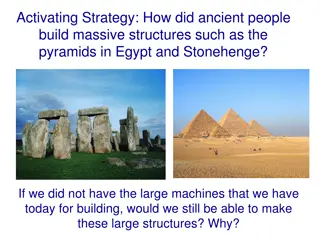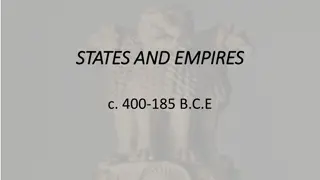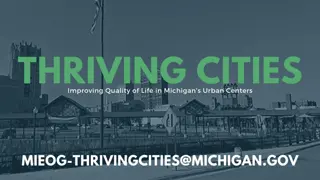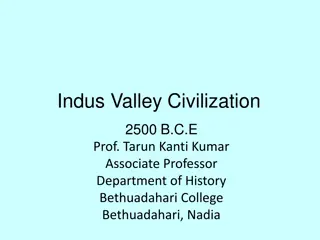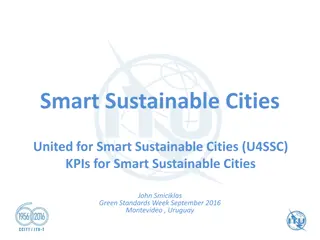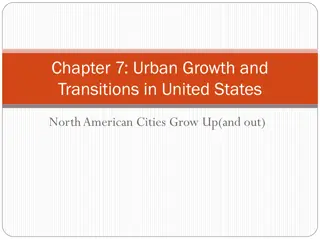Evolution of Cities: From Ancient Origins to Modern Developments
Settlements and cities have evolved over millennia due to factors like geographical obstacles, social divisions of labor, and economic needs. From ancient civilizations in Mesopotamia and Egypt to the urban expansion during the Roman Empire and the Industrial Revolution, cities have grown at locations offering strategic advantages like trade routes, river-crossings, and coastal areas. The evolution of cities reflects changes in social structures, economic activities, and technological advancements, shaping urban landscapes worldwide.
Download Presentation

Please find below an Image/Link to download the presentation.
The content on the website is provided AS IS for your information and personal use only. It may not be sold, licensed, or shared on other websites without obtaining consent from the author.If you encounter any issues during the download, it is possible that the publisher has removed the file from their server.
You are allowed to download the files provided on this website for personal or commercial use, subject to the condition that they are used lawfully. All files are the property of their respective owners.
The content on the website is provided AS IS for your information and personal use only. It may not be sold, licensed, or shared on other websites without obtaining consent from the author.
E N D
Presentation Transcript
II M.Sc. APPLIED GEOGRAPHY GOVERNMENT COLLEGE FOR WOMEN (A) KUMBAKONAM POPULATION AND SETTLEMENT GEOGRAPHY TITLE : THE ORIGIN OF CITIES TITLE : THE ORIGIN OF CITIES 29.09.2020 & 03.10.2020 29.09.2020 & 03.10.2020 PRESENTED BY S. MAHESWARI GUEST LECTURER IN GEOGRAPHY
THE ORIGIN OF TOWNS AND CITIES THE ORIGIN OF TOWNS AND CITIES Blache (1965, 471) observed : A study of the growth of cities in the past shows that what made the seed spring to life and guaranteed its growth, was usually an obstacle. At borders of mountain barriers or at river-crossing, on the edge of deserts, on the sea coasts, in short, wherever it is necessary to halt and to find new methods of transportation there is opportunity for city growth. R.E.Dickinson, studying the growth of the historic city observed : 1. Greek civilization began in the Aegean lands, and there its earliest city states were located, while the Greek colonial city was founded on the coast lands of theMediterranean, specially in southern Italy.
2. Roman civilization spread the city idea not only throughout the Mediterranean but also, for the first time, to the main land of Europe north of the Alps. 3. With the end of Roman Empire urban life declined and almost disappeared. 4. The second great phase of urban growth took place during the nineteenth century when the Industrial Revolution had its beginning in England and the adjacent countries of European mainland.
Origins and evolution of cities in the preindustrial period Cities in ancient times The emergence of settlements was the result of the first social division of labor, i.e. the allocation of the first farmers. Later, the separation of crafts and their concentration in certain settlements took place - the first cities arose (the so- called second social division of labor). The emergence of the cities was the result of third social division of labor, i.e. the separation of the exchange of goods from crafts. Pre-industrial city became the center of an agricultural area and concentrated trade and crafts. The foundation of the city from the earliest times until the industrial revolution consists of: crafts, trade, defensive function, administrative functions.
The originated in the 5th to 2nd millennium BC in the Middle (Mesopotamia, Iran and Egypt), Urban gradually expanded into other areas Mediterranean Rome, the "Roman" new towns that were created as military camps / e.g. Cologne, Vienna, Barcelona, Paris, London /). oldest towns East civilization of (Greece, the Strasbourg, Budapest, Marseille,
The oldest settlements originated on the hills, especially for security and defense reasons: Jericho, Babylon, Mennofer (Memphis) Carthage, Troy, Mycenae, Olympia, Delphi, Sparta and Athens, Miletos, etc. Overview of the oldest cities of the world and the period of their creation
Ancient cities were characterized by regular layout and showed common features of the city: The landmark was the palace of the ruler, temples and palaces of the courtiers, Cities were very extensive, Various neighborhoods were formed, Often showed a large population. The main building material in the Antiquity and in the Middle Ages was wood, stone was used only for the foundations of houses, larger buildings and religious objects. Fig. The layout of the city of Miletos: 1 marketplace 2 town hall 3 amphitheater 4 stadium Since Roman times (and then subsequently up to the 19th century) bricks are used in construction.
Cities in the Middle Ages After the collapse of the Western Roman Empire the Rhineland followed the ancient tradition - the "idea" of a city spread further into eastern, northeastern and southeastern Europe. From the 3rd century, due to Migration Period, the structure of population in cities was altered - the rich part of the population was suppressed, primarily artisans and traders remain. Breakthrough in the evolution of the city is significant in 8th-9th century when princes and bishops begin to establish their castles and monasteries. Royal and ecclesiastical seats then often become the core of the settlement, around which the city life evolves. Each period of the Middle Ages was associated with a particular architectural style, which was also connected with a function or meaning of the cities: Romanesque, Gothic style Renaissance, Baroque.
Cities of the industrial era In the modern era the nature of economic activity is qualitatively changing - agriculture is more mechanized and released labor force is heading to the cities. In the 18th-19th century a new town function is created - the industrial production. Industrial development would significant social and economic changes, which we call the Industrial Revolution. With the industrial revolution a large number of people is beginning to be employed in large-scale production in cities (at the beginning manufactures, later factories), and significant population movements from rural to urban areas occurs. The localization factor for urban development or industrial period is mineral fuel (coal).Therefore, most of these cities develop in mining areas. not be possible without
Industrial development retrospectively influenced the development of other urban functions: Trade; Finance; Administration; Education and culture. A very important factor then becomes transportation, because sufficient water resources were required in addition to the fuel. For this reason, the settlement also develops around rivers and in the lowlands. Due to population growth in cities and urban sprawl the original medieval fortifications (walls) are vanishing and in its place industrial buildings or warehouses are built. Formerly farming villages near the city merge with large cities and become their suburbs.
The main feature of urban-industrial period is: the rapid growth of urban population: In 1800 in the whole world there were about 750 cities over 5 thousand inhabitants, 200 cities over 20 thousand inhabitants and 45 cities over 100 thousand inhabitants and no city had more than 1 mil. inhabitants; In 1950, in the same categories there were 27600, 5500, 880 and 50 cities. Urban phenomenon affected all regions of the world: Old network of medieval towns, but also new cities in the coalfields and around railways, the area where cities were absent (North America, Australia). In Asia and Africa among the indigenous towns new colonial cities were created(eg. Shanghai, Hanoi, New Delhi, most cities in sub-Saharan Africa). Areal expansion of cities into surrounding communities; With the growth of cities differentiation of urban design occurs, which subsequently leads to social differentiation.
Cities of the postindustrial epoch In the postindustrial era, the economic transformation is reflected in the transition from an economy based on secondary sector (manufacturing) to an economy based on the tertiary sector (services). The national and global capital (which reflects, among other things demand a new standard of living = emphasis on mental work, reducing working time, leisure, development, ...) is extending. Changes in production technology and modern way of buying goods puts greater demands as far as area is concerned. New productions (e.g. car assembly) and superstores are built on previously undeveloped areas close to the city limits. The condition is a good communication network allowing easy and especially fast access (see AMAZON - Brno). Urbanization of postindustrial period affects still larger areas. Cities are expanding into rural areas and are changing the economic and cultural character of the village. individualization, informatics
Thank you Thank you









